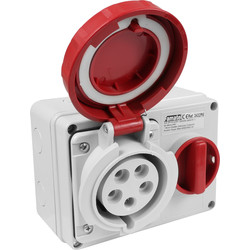Ooh, interesting one. I assume you mean you have a 3P circuit which you don't need to run anything 3P - so you stick (say) 3off BS1363 double sockets off the end of it, one per phase, all sharing one neutral.
As long as the phases all share a linked protection device, then I'm not sure there would be anything against it. You could not have spearate protection (i.e. 3off single phase breakers) because you are not allowed shared neutrals like that.
The only thing I can think of would be the requirement to provide segregation of circuits so as to minimise danger or inconvenience when one of them trips - in this case, if any of the 3 loads causes the breaker to trip, then all 3 will go off. However, since this is likely to be a radial, you could argue that it's not like having all the sockets in your house on one circuit - there are likely to be other sockets around - and in any case you aren't going to lose your lights.
In some ways it would be better than 3off single phase radials of the same characteristics. As long as more than one phase is loaded, the volt drops would be less than with separate circuits - and of course it uses less copper, could be 5 cores vs 9 cores for separate circuits.
As long as the phases all share a linked protection device, then I'm not sure there would be anything against it. You could not have spearate protection (i.e. 3off single phase breakers) because you are not allowed shared neutrals like that.
The only thing I can think of would be the requirement to provide segregation of circuits so as to minimise danger or inconvenience when one of them trips - in this case, if any of the 3 loads causes the breaker to trip, then all 3 will go off. However, since this is likely to be a radial, you could argue that it's not like having all the sockets in your house on one circuit - there are likely to be other sockets around - and in any case you aren't going to lose your lights.
In some ways it would be better than 3off single phase radials of the same characteristics. As long as more than one phase is loaded, the volt drops would be less than with separate circuits - and of course it uses less copper, could be 5 cores vs 9 cores for separate circuits.


